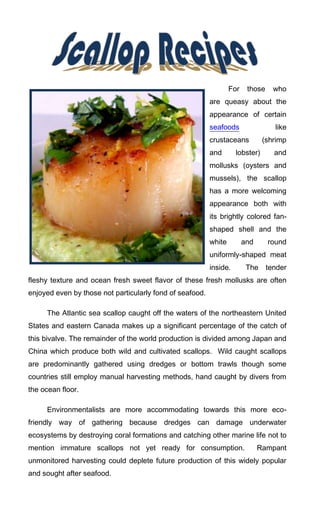
4.13.16 scallop recipes
- 1. For those who are queasy about the appearance of certain seafoods like crustaceans (shrimp and lobster) and mollusks (oysters and mussels), the scallop has a more welcoming appearance both with its brightly colored fan- shaped shell and the white and round uniformly-shaped meat inside. The tender fleshy texture and ocean fresh sweet flavor of these fresh mollusks are often enjoyed even by those not particularly fond of seafood. The Atlantic sea scallop caught off the waters of the northeastern United States and eastern Canada makes up a significant percentage of the catch of this bivalve. The remainder of the world production is divided among Japan and China which produce both wild and cultivated scallops. Wild caught scallops are predominantly gathered using dredges or bottom trawls though some countries still employ manual harvesting methods, hand caught by divers from the ocean floor. Environmentalists are more accommodating towards this more eco- friendly way of gathering because dredges can damage underwater ecosystems by destroying coral formations and catching other marine life not to mention immature scallops not yet ready for consumption. Rampant unmonitored harvesting could deplete future production of this widely popular and sought after seafood.
- 2. Scallops possess two types of meat namely the adductor muscle which is the white, firm and meaty portion, and the soft white or red “roe”, also called the "coral". Markets usually sell them with the adductor muscle still intact in the shell. This is a more prized ingredient and is carefully prepared oftentimes using the shell in the presentation. For mass production and export, scallops can be frozen without any additives or treated with chemical salts that enable them to absorb moisture prior to the freezing (thereby getting a better price per unit weight). For raw dishes like ceviche and sushi, it is highly recommended to go for fresh. Same goes for salad dishes and grills. Dried salted scallop called conpoy is widely used in Cantonese cookery and is a main ingredient in X.O. (extra ordin ary) sauce combi ned with other dried seafo od, chili, garlic, onions and oil. It is a great flavoring for vegetable, meat and fresh seafood dishes. When using this sauce which is savory, sweet, salty and spicy all at the same time, go easy on the salt.
- 3. For western dishes, these are used in a wide variety of applications from soups to appetizers to entrees. In countries with no coastline that have to rely on its importation, these can be a pricey menu item and are often prepared with extra care and gourmet ingredients. Visit us @www.gourmetrecipe.com
